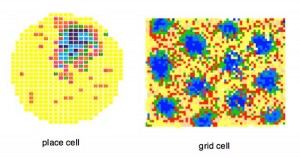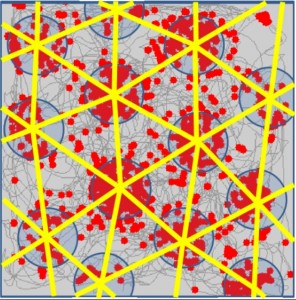I first learned of place cells and the work of neuroscientists to locate sense of place in the brain from an article published in the New Scientist in 2006 (John Zeisel, “A Sense of Place,” New Scientist 4 March 2006, 50-51). My initial reaction was that this was scientific reduction, taking something remarkably subtle and complex and explaining it in terms of a physiological mechanism. I became less dismissive when I discovered that this research was in part an attempt to find a underlying cause for Alzheimer’s, in which a sense of place (in the fundamental meaning of knowing where you are and how you got here) is one of the first faculties to drift away, and there is some indication that damage to place cells could be a cause. And as I have learned more I have come increasingly to think that the research of neuroscientists provides valuable insights that complement rather than undermine phenomenological thought about place.
There are growing indications that “place cells” and “grid cells” – the neurons in our brains that react to specific locations – play key roles in our experiences of places. The three key scientists involved in the discovery of these cells – John O’Keefe, and Edvard and May-Britt Moser – were awarded the Nobel Prize in the Physiology of Medicine in 2014, and the nomination stated that: “The sense of place and the ability to navigate are some of the most fundamental brain functions. Sense of place provides a perception of the position of the body in the environment and in relation to surrounding objects.” Furthermore it is linked to experiences of distance and direction, and to memory.

Diagrams recording place cell firing and grid cell firing in respective parts of the brain. Yellow indicates no firing of an electrode, other colors fire when the animal was in a particular part of the maze. The place cell patterns are unorganized and do not correspond to actual spatial patterns. Grid cell firings have a hexagonal pattern.
Place and Grid Cells
Place cells were identified and named by O’Keefe in 1971. He connected electrodes to the hippocampi of rats moving freely around mazes, and discovered that whenever a rat was in a certain part of the maze a particular neuron fired – each place in the maze apparently had its own neuron. Hence “place cells.” There was, however, no apparent correspondence between the patterns of place cells in the brain and the spatial relationships of actual places. This puzzle was resolved thirty years later when the Mosers identified what they called “grid cells” in the entorhinal cortex (a part of the brain adjacent to the hippocampus) which, in effect, organize the relationships of distance and direction between place cells. It has been suggested that together place and grid cells construct a sort of cognitive map of the world as we experience it.

The hexagonal pattern of grid cell firing. The grey, wavy line in the background shows the movement of a freely moving rat in an experimental cage. The firing pattern of grid cells is superimposed – locations at the intersections of the grid lines generated repeated firings to create the hexagonal patterns.
[Two related notes:
1. Other related types of neurons related to spatial experience have been identified – such as head-direction cells and border or boundary cells – which also contribute to how place memories are stored in the brain.
2.Grid cells are remarkable not only for their apparent organizational role in brain activity, but also because their firing patterns seem to take the form of a hexagonal grid, strangely reminiscent of the patterns in what in Geography is known as Central Place Theory. I have no idea what to make of this.]
Memory
Place and grid cells are in parts of the brain known to play critical roles in memory. It has been established that their functions are related not only to remembering how to get from place to place but also to episodic memories – memories related to one’s own experiences. It has also been established that there is “plasticity” in these memories of places. In other words, even if some of the characteristics of a place are changed, such as colours, or heights of walls, or lighting, the same place cell continues to respond to it.
Place and Grid Cells in Humans
How is this known to happen in humans? Individuals having brain surgery for other reasons, such as treatment for acute epilepsy, and are therefore immobilized, have agreed to participate in experiments involving virtual reality. Their brain activity has been monitored as they navigate through a virtual city where they are asked to undertake tasks at specific locations, and then to recall aspects of those locations and tasks. Firing patterns in place and grid cells are consistent with those in laboratory animals.
Implications
What does this mean for understanding place and sense of place in what might be called the geographical world of home, neighbourhood, city, other countries?
Clearly place and grid cells have to be functioning well if we are to find our way around, whether it is from the living room to the kitchen and back again, or around the cities we live in. We know this because those suffering from Alzheimer’s lose that ability and it appears this may be related to atrophy or malfunction of place and grid cells. In effect, place and grid cells hold the memories, meanings and sense of places.

The relationship between places and episodic memories captured in a sign in store window in Victoria British Columbia
More philosophically, it appears there is a complex correspondence between what I perceive and experience in the geographical world and what goes on in my brain. If I understand the neuroscience research correctly, there is in my brain a neuron which somehow stores or is related to my memories for each place I have experienced, whether my kitchen, the house my grandfather built that I lived in fifty years ago for a few years, or the view of Florence from the other side of the Arno. This is a huge amount of information and it all has to be sorted and recalled easily if we are to find our way around and talk about where we grew up and went on vacation. May-Britt and Edvard Moser and David Rowland put it this way in their Cold Spring Harbor article: “Spatial memories place high demands on capacity. Memories must be distinct to be recalled without interference and encoding must be fast…for large quantities of uncorrelated spatial information.”
Given this, I think the cognitive map metaphor is too simple, not least because it assumes that place and grid cells function mostly as recording devices of places that exist in a real world. My interpretation is that research into place and grid cells is demonstrating the remarkable complexity and flexibility of place experience in which the relationship between the geographical world and place and grid cells is dynamic and two-directional, continually changing both as things in the world change and as memories are accumulated. Place and grid cells record our experiences of places as memories, and the memories stored in those cells continually inform our experiences of places. By extension, notions of an objective world that is separate from subjective experience seem to have no neurological substance. What goes on in our brains, and what goes on in the world those brains encounter are so profoundly interconnected that to separate them has to be considered equivalent to self-imposed dementia. Phenomenologists have always suspected as much.
Some References:
A substantial recent review of work on place, grid and related cells, by the Mosers who won the Nobel Prize and David Rowland, is available at Cold Spring Harbor Perspective in Biology at:
http://cshperspectives.cshlp.org/content/7/2/a021808.full
The connection between place and grid cells and Alzheimer’s is discussed at http://www.kavlifoundation.org/science-spotlights/understanding-our-sense-place#.VicTyKTWr3U
The following article from Frontiers in Systems Neuroscience discusses the link between place cells and episodic memory:
http://www.ncbi.nlm.nih.gov/pmc/articles/PMC4148621/
Brain Facts discusses the evidence of place and grid cells in humans.
http://blog.brainfacts.org/2013/08/human-grid-cells/#.ViRyfaTWr3V